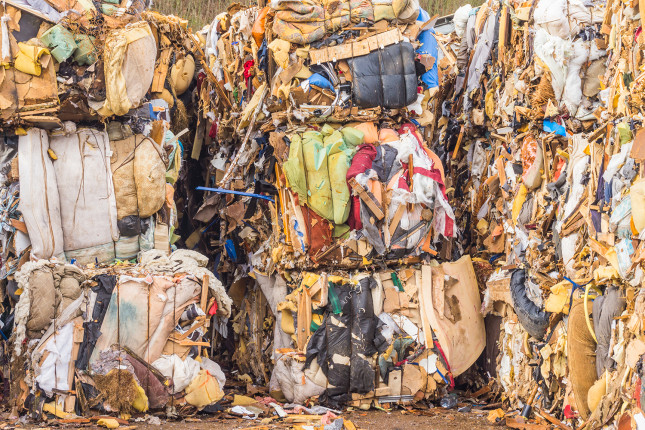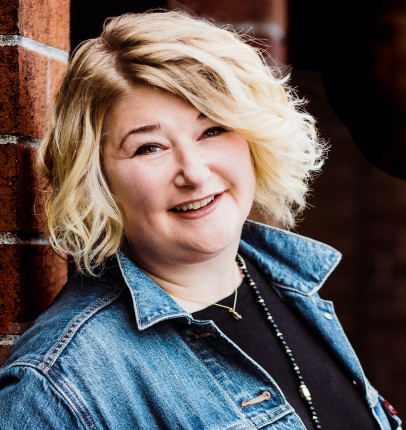-
Closing the Loop on Fashion Waste: Q&A with Evrnu cofounder Stacy Flynn

Stacy Flynn is intimately familiar with the ins and outs of fashion’s supply chain. She knows how clothes travel the world as they move through the stages of design, textile production, and garment formation before landing in your local retail store. For years, she managed these supply chains for Dupont and Target, making regular visits to suppliers in China who showed her pristine manufacturing facilities where she examined textile and clothing samples and discussed prices and delivery. Nothing could have prepared her for when she returned in 2010 with a Seattle-based startup to tour smaller textile and dyeing factories, and saw the staggering pollution these second and third tier suppliers generated. Her guides told her that during periods of increased textile production, wastewater emissions turn the rivers deep unnatural hues and factory exhaust smothered the air outdoors and even indoors for the workers.
Stacy soon began a mental tally of the millions of yards of fabric she had handled throughout her career and their associated environmental cost. The pride she held for her profession quickly soured. At a crossroads, she asked herself, “Is this how the story ends, is this our state or is there another way for the fashion industry?”
The current global fast fashion model encourages the rapid design of inexpensive seasonal clothing. This fast-paced supply chain produces over 92 million tons of waste each year and consumes 79 trillion liters of water. Cheap synthetic fibers that make lightweight and durable fabrics fuel this industry, but the environmental cost is high and long-lasting. In 2015, the annual greenhouse gas emission from polyester production for textiles reached the equivalent impact of 185 coal-fired power plants. Polyester fabrics are particularly harmful because while wearing or washing they can shed plastic microfibers at an alarming rate. Scientists are currently uncovering how these microfibers are accumulating in our seabeds, national parks, seafood, and homes.
Evrnu is a collaboration between Stacy Flynn and Christopher Stanev to counter the impact of the fashion industry on natural resources by licensing their supply-side innovations to global producers. Evrnu’s innovative NuCycl technology strips old garments down to their component fibers to produce a stronger end material capable of reuse. They are modernizing the textiles industry by designing waste out of supply chains and leveraging discarded textiles as resources for the future.
Evrnu is making leaps and bounds in both innovation and advocacy through its collaborations with Adidas and Stella McCartney and Levi Straus & Co, and appearances in national industry alliances to promote the UN Sustainable Development Goals. We sat down with Stacy to discuss Evrnu’s business model and why her company is uniquely poised to propel our understanding of fashion forward into the future.

China Environment Forum: What does it mean to redefine the textile industry supply chain?
Stacy Flynn: As a world and where our industry is, we keep repeating the same formula hoping for different results. Focusing on the future really does require us to think creatively and more holistically about what the solutions can be by starting small and scaling them over time.
We’ve seen the negative environmental impacts and limits to our growth with the current way of doing business. What if we start designing our products with the intent to recycle them in the future? What if waste byproducts of textile products in the future are used to create the supply chain rather than mining raw materials?
CEF: What makes Evrnu’s recycling technology unique?
SF: You can take waste and turn it into something else, but if that something else has a fate that ends up in a landfill or incinerator, you’ve only created a delay to the inevitable waste. Our NuCycl technology is unique because it redesigns the product to enable more complete upcycling and reuse in the future. Our research focuses on garment-to-garment recycling and garment-to-downcycle technologies that include patents for turning textile waste into different kinds of paper for cardboard, packaging, and things like that. Our technologies will provide end of life solutions for textile waste that are benign to our environment.
Right now businesses are predicated on producing a large amount at a low price. As a result, they have not kept up with the pace of innovation because there is no money to invest in it. Our technologies are designed to redistribute the incentives so there is clear value for the entire supply chain. We are redefining the value proposition by creating products that align with consumer’s values of reducing impact and training consumers to recycle their products so we can convert them back into new materials and provide access to them in different forms.
CEF: The garment-to-garment recycling process is integral to Evrnu’s success. How does the closed loop process start?
SF: In the United States, we throw away 17 million tons of clothing waste every year. Only 20 percent of this clothing waste is donated to charities like Goodwill and Salvation Army, so by far the majority of textile waste is going into the garbage and ultimately into the landfill. Out of the percentage that is donated, charities try to resell or reuse as much as they possibly can. Whatever cannot be sold gets sent to garment recyclers who manually sort and process it for secondary markets that are usually emerging markets. Things that cannot be re-sold or re-worn have to go directly into the landfill and that is where our technology is designed to intersect.
We want to reduce the amount of textiles going to landfill as much as possible by mining or disassembling those polymers and re-polymerizing them back into new materials for a high-value new product. This waste supply chain exists now and as we start donating more and more old textiles to the supply chain for sorting and separating, it will continue to expand around the world.
CEF: What does the future hold for NuCycl?
SF: That’s the million dollar question. When you own your own factory you can control your own destiny, but the drawback with owning your own factory is that it is very expensive. We’ve opted to go with a licensing model because we don’t have to build facilities, however we are often at the mercy of the supply chain. So we’ve had to work really hard over the last two years to build strong relationships with waste owners, paper pulping mills, and fiber producers to properly intersect the existing waste supply chain. It’s a very long process, like a symphony that requires end-to-end supply chain partnerships to be successful.
Our initial technology turns cotton waste into pulp that can be passed through the same solvent system that is currently used for dissolving wood pulp. The current system has been specifically designed for trees, so fitting into the fiber production system [with our Regenerative Cellulosics technology] has taken time and we are now finishing the final phase of development to get the quality dialed in with the fiber producers so they can make commercial fibers out of our pulp. Next year we will stand up the pulp business by integrating the owners of the pulp mills with the fiber producers. We intend to bring between three to six brands to market next year.
CEF: Are regulations emerging to facilitate a redesign of the textile industry?
SF: We are starting to see the European Union creating strong policies on the environmental impact of the textile industry. For example, Ireland and France have both outlawed garments going to landfill. The environmental damage of the textile industry is a colossal problem that affects humanity but no one is putting money into it because a lot of professional investors think it is a woman’s problem. We have to change the fashion business in a way that makes sense for it, and for this to work we have to find people who believe it is possible.
This blog is the first in a new Closed Loop Innovator Series, profiling stories of women around the world innovating in business, civil society, and science to reduce plastic waste pollution. A condensed version will appear in the upcoming China Environment Forum publication, InsightOut: Closing the Loop on Plastic Waste in China and the U.S.
Clare Auld-Brokish is a research assistant at the Wilson Center’s China Environment Forum where she is working on urban water issues in China and global plastic waste. She recently returned from a Fulbright fellowship in Yunnan, China where she conducted environmental science research on freshwater lakes and constructed wetlands.
Tongxin Zhu is a research assistant at the Wilson Center’s China Environment Forum. Her current focus is ocean plastic waste in China with an emphasis on consumer-facing industries. She recently graduated from Georgetown University, McCourt School of Public Policy with an MPP degree.
Sources: Eunomia, Greenpeace, National Parks Conservation Association, Nature Reviews Earth & Environment, Plastic Soup Foundation, The Guardian, UN Development Programme, World Resources Institute
Lead Photo Credit: The global fast fashion industry produces over 92 million tons of waste each year, courtesy of Shutterstock.com.
 A Publication of the Stimson Center.
A Publication of the Stimson Center.




